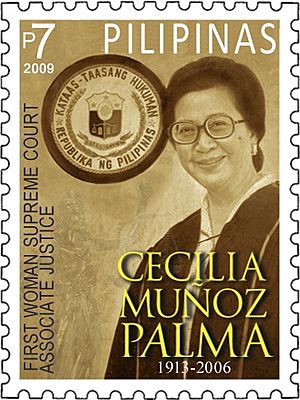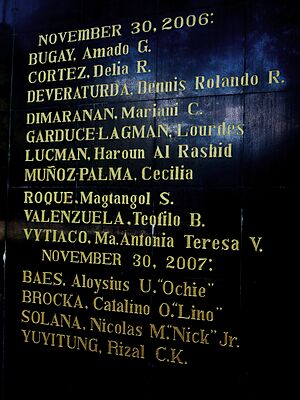Cecilia Muñoz-Palma facts for kids
Quick facts for kids
Cecilia Muñoz-Palma
|
|
|---|---|
 |
|
| Chairperson of the Philippine Charity Sweepstakes Office | |
| In office 1998 – January 31, 2000 |
|
| Appointed by | Joseph Estrada |
| Chairwoman of the 1986 Constitutional Commission | |
| In office June 2, 1986 – October 15, 1986 |
|
| Appointed by | Corazon Aquino |
| 89th Associate Justice of the Supreme Court of the Philippines | |
| In office October 29, 1973 – November 22, 1978 |
|
| Appointed by | Ferdinand Marcos |
| Preceded by | Newly created seat |
| Succeeded by | Ameurfina Melencio-Herrera |
| Mambabatas Pambansa (Assemblywoman) from Quezon City | |
| In office June 30, 1984 – March 25, 1986 Serving with Ismael Mathay Jr., Orlando Mercado, and Alberto Romulo
|
|
| Personal details | |
| Born |
Cecilia Arreglado Muñoz
November 22, 1913 Bauan, Batangas, Philippine Islands |
| Died | January 2, 2006 (aged 92) Quezon City, Philippines |
| Political party | UNIDO (1984–1986) |
| Spouse | Rodolfo Palma |
| Children | 3 |
| Alma mater | University of the Philippines Manila (LL.B.) Yale University (LL.M.) |
Cecilia Arreglado Muñoz-Palma (November 22, 1913 – January 2, 2006) was a very important Filipino jurist, which means she was an expert in law. She made history as the first woman to be appointed to the highest court in the country, the Supreme Court of the Philippines.
President Ferdinand Marcos appointed her to the Supreme Court in 1973. She served there until she turned 65. Even while on the Court, she bravely disagreed with some of President Marcos's decisions, especially those related to martial law.
After she retired, Muñoz-Palma became a key leader against Marcos's government. She was even elected to the Batasang Pambansa, which was like the parliament at the time. When Corazon Aquino became president after the People Power Revolution in 1986, Muñoz-Palma was chosen to lead the group that wrote the new 1987 Constitution.
Contents
Early Life and Education
Cecilia Muñoz-Palma was born in Bauan, Batangas. Her father, Pedro P. Muñoz, was a representative in the House of Representatives of the Philippines. She was a very bright student.
She graduated as the top student from St. Scholastica’s College in 1931. She then studied law at the University of the Philippines and earned another law degree from Yale Law School in the United States.
While in law school, she was the first woman to lead the student council. She also won many awards for her speaking and debating skills.
A Trailblazer in Law
Cecilia Muñoz-Palma showed everyone that women could excel in law. In 1937, she got the highest score on the Philippine Bar exams, which lawyers must pass.
She continued to break barriers:
- In 1947, she became the first woman prosecutor in Quezon City.
- Seven years later, she was the first female district judge in Negros Oriental.
- She later served as a judge in Laguna and Rizal.
- In 1968, she became the second woman ever appointed to the Philippine Court of Appeals.
- Finally, in 1973, she made history again as the first female Supreme Court Associate Justice.
Standing Up for Justice
Justice Muñoz-Palma was known for her courage. While serving on the Supreme Court, she often disagreed with rulings that supported President Marcos's martial law. She believed that people could not truly express their will under martial law because of fear.
She even said that martial law meant "power of the gun" and "coercion by the military." She bravely called for martial law to be lifted.
Fighting for Democracy
After retiring from the Supreme Court in 1978, Muñoz-Palma became a strong voice against President Marcos. In 1984, she was elected as an Assemblywoman for Quezon City.
She worked to unite all groups that opposed Marcos. She also strongly supported Corazon Aquino to run for president against Marcos.
Shaping the New Constitution
When Corazon Aquino became president in 1986, she asked Cecilia Muñoz-Palma to lead the group that would write a new Constitution for the Philippines. This new Constitution was very important for bringing back democracy.
After the 1987 Constitution was approved, Muñoz-Palma stepped back from public life for a while. However, she continued to serve the country. In 1998, she supported Joseph Estrada for president. After he was elected, he appointed her to lead the Philippine Charity Sweepstakes Office. She resigned from this role in 2000.
Cecilia Muñoz-Palma passed away on January 2, 2006, at 92 years old.
Legacy and Recognition
Cecilia Muñoz-Palma's contributions are still remembered today. In 2006, her name was added to the Bantayog ng mga Bayani. This monument honors people who fought against the Marcos dictatorship and helped bring back democracy in the Philippines.
In 2009, she was inducted into the International Women’s Forum's International Hall of Fame. Her family and friends also created the Justice Cecilia Muñoz Palma Foundation to continue her work. A street in Manila was also named in her honor.
Personal Life
Cecilia Muñoz-Palma was married to Rodolfo C. Palma, who was also a lawyer. They had two sons and one daughter.
Images for kids



